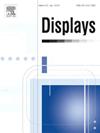Perspective distortion correction in a compact, full-color holographic stereogram printer
IF 3.7
2区 工程技术
Q1 COMPUTER SCIENCE, HARDWARE & ARCHITECTURE
引用次数: 0
Abstract
Holography technology has advanced so much that it is now possible to record the object wavefront information on thin holographic recording media. Holographic stereogram printing techniques capture numerous ’hogels’—the smallest unit in holographic printing—storing an extensive range of optical information that surpasses the capabilities of other holographic applications. In this paper, we design a compact holographic stereogram printer that utilizes optical fibers to achieve significant system miniaturization. Specifically, the integration of polarization maintaining/single mode (PM/SM) fibers allows for the customization of the printer’s optical path. However, due to the wide field of view of our holographic stereograms, perspective distortion is hard to be avoided especially when the wavelengths or positions of the light source are not the same as designed values. The flat transverse plane is bent if the light source deviates from the optical axis. This distortion is easily understood by using a k-vector diagram, which illustrates how the direction of the outgoing light’s k-vector changes when it is diffracted by the grating vector of the volume hologram due to the incident light with undesirable direction. In this paper, the feasibility of our perspective-distortion correction algorithm is experimentally demonstrated.
小型全彩色全息立体图打印机中的透视畸变校正
全息技术的发展使得在薄全息记录介质上记录物体波前信息成为可能。全息立体图印刷技术捕获了许多“霍格”——全息印刷中最小的单位——存储了广泛的光学信息,超过了其他全息应用的能力。在本文中,我们设计了一个紧凑的全息立体图打印机,利用光纤实现了系统的小型化。具体来说,偏振保持/单模(PM/SM)光纤的集成允许定制打印机的光路。然而,由于我们的全息立体图的视场很宽,尤其是当光源的波长或位置与设计值不一致时,透视失真是很难避免的。当光源偏离光轴时,平坦的横向平面发生弯曲。这种畸变很容易通过使用k矢量图来理解,k矢量图说明了由于入射光具有不良方向,当出射光的k矢量被体全息图的光栅矢量衍射时,其方向如何变化。本文通过实验验证了该算法的可行性。
本文章由计算机程序翻译,如有差异,请以英文原文为准。
求助全文
约1分钟内获得全文
求助全文
来源期刊

Displays
工程技术-工程:电子与电气
CiteScore
4.60
自引率
25.60%
发文量
138
审稿时长
92 days
期刊介绍:
Displays is the international journal covering the research and development of display technology, its effective presentation and perception of information, and applications and systems including display-human interface.
Technical papers on practical developments in Displays technology provide an effective channel to promote greater understanding and cross-fertilization across the diverse disciplines of the Displays community. Original research papers solving ergonomics issues at the display-human interface advance effective presentation of information. Tutorial papers covering fundamentals intended for display technologies and human factor engineers new to the field will also occasionally featured.
 求助内容:
求助内容: 应助结果提醒方式:
应助结果提醒方式:


